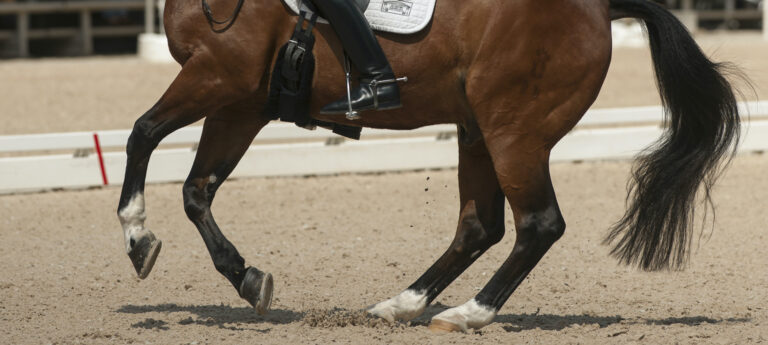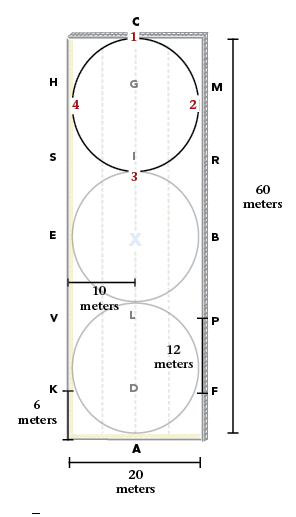Q: My mare’s legs are always slightly puffy when I take her out of her stall. The puffiness often goes away during my ride. My gelding doesn’t seem to have the same problem. They get the same amount of turnout (eight hours a day) and are ridden for an hour at Third Level dressage every day. What causes my mare’s stocked-up legs? Is this a problem? Is there anything I can do to prevent her legs from stocking up?
Sandrine Davidson
Annapolis, Maryland
Greg Staller, DVM

A: “Stocking up” is a horseman’s term for edema of the lower limbs that occurs without pain, heat or lameness. Medically, stocking up is a condition known as orthostatic hypertension. Simply, because the horse’s heart and the majority of its mass is much higher than the limbs, gravity causes in fluid leaking out of the bloodstream and lymph system into the spaces in the tissue of the leg, resulting in edema. Edema is simply fluid in the tissues outside of the bloodstream or lymphatic system.
While gravity is at play in the development of a horse stocking up, there are many factors that make one horse more susceptible to it than others. In a horse that does not stock up, the bloodstream and lymphatic system take fluid out of the limb via the circulation and through a normal steady state. The fluid entering the limb leaves it within the circulation. With a horse that stocks up, some fluid is lost from the blood vessels into the tissue spaces. Any condition that leads to inflammation in the limb would allow some fluid to leak from the blood vessels and make a horse more likely to stock up. Examples of such inflammatory conditions could include allergies to food, bedding and other things in the environment such as mold or dust, local mild dermatitis or skin conditions, or responses to work and exercise or even changes in shoeing.
Allergies result in leaky blood vessels all over the body. Edema or stocking up occurs in the limbs, again, because of gravity. Inflammation in the skin from mild irritation or infection will induce leakage of fluid from the bloodstream into the tissues. In the same way, inflammation induced in the limbs from work can lead to leaky blood vessels and result in stocking up.
The foot of the horse has some special structures that allow it to function as a pump to assist in moving fluid in the circulation back up the limbs. The frog, digital cushion and collateral cartilages of the foot contain miles of veins with one-way valves. Since veins are blood vessels that carry blood away from the extremities and back to the heart, and are under low pressure, the one-way valves assure that blood continues to move in one direction. When the foot lands on the ground, pressure develops within it that forces blood out of it, up the limb, assisting with the movement of blood and lymph back toward the heart. Shoeing a horse alters this system as does confining him to a box stall. When it comes to stocking up, some horses are more sensitive to shoeing or confinement than others.
In most cases, stocking up is benign, but action should be taken to improve the situation because edema in the limbs can make the tissues more susceptible to infection and reduces flexibility and movement in the limbs. Identifying whether overwork or the exercise regimen is causing the stocking up is important. Careful evaluation of shoeing can also result in reduced stocking up; some horses do better with sole/frog support by increasing contact of these structures with the ground surface. A shoe that is sufficiently large allows better movement of the foot. Avoiding bar shoes can also help. Identifying and reducing exposure to allergens can help reduce the incidence of stocking up. Care of the skin of the lower limb is important, especially in the warmer months when horses are ridden and bathed often. Gravity again results in water on the horse concentrating on the lower limbs, where the moisture can lead to mild irritation. Carefully towel-drying the skin and using powder can help. Standing bandages should be used with care for the management of stocking up as the horse may become dependent on their use and further problems with the skin can develop.
Greg Staller, DVM, DACVS, graduated from the University of California at Davis. After completing an internship and residency in large animal surgery at New Bolton Center in Pennsylvania, he became board-certified as a Diplomate of the American College of Veterinary Surgeons in 1995. He is a certified FEI dressage veterinarian and operates Running ‘S’ Equine Veterinary Services in Califon, New Jersey (runningsequine.com).











